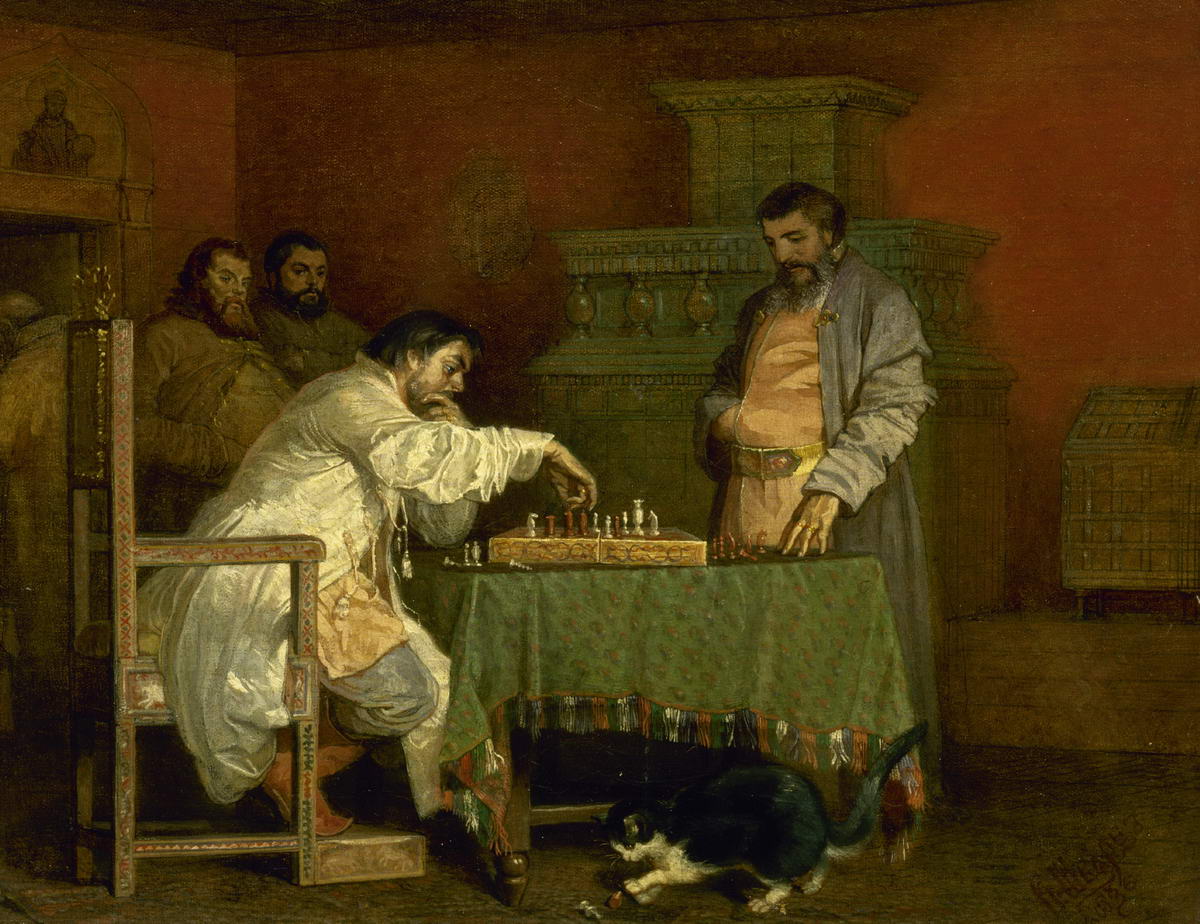


Вячеслав Шварц, бывший родоночальником историко-бытового жанра в русской живописи, изобразил Алексея Михайловича за игрой в шахматы с одним из бояр. Это было любимое развлечение царя в кругу близких ему людей, с которыми он любил уединяться в вечернее время. Игра пользовалась при Дворе такой популярностью, что в Оружейной палате состояли на службе особые мастера, занимавшиеся изготовлением и починкой шахмат. Екатерина Шилова. Каталог выставки в Малаге "Династия Романовых". 2017. С. 106/107.
<...> Шварц создал цикл иллюстраций и живописных композиций, раскрывающих драматические эпизоды романа А. К. Толстого «Князь Серебряный», а также серию небольших камерных, тонко и изящно написанных исторических картин, в которых проявил себя как непрестанно ищущий художник-новатор, тяготеющий к жизненной правде и точному знанию. Воссоздать, основываясь на исторических фактах, повседневную жизнь своего главного исторического персонажа – царя Алексея Михайловича, найти характерные образы допетровской Руси, предельно достоверно показать не только нравы, но и обстановку, одежду, утварь далекого прошлого и вместе с тем живописно опоэтизировать свои сцены – такие задачи решал в своих произведениях мастер, искусство которого находило много точек соприкосновения с современной жанровой живописью. Шувалова И. Н. Русское искусство 1860-х годов – вокруг Перова // Святые шестидесятые». Живопись, графика, скульптура. СПб. 2002. С. 28.
Шварц обращается к психологически правдивому изображению человека, к исторически конкретной передаче эпохи. Интерьер небольшой комнаты типичен для середины XVII века. Художник с особой тщательностью, любуясь, выписывает предметы – изразцовую печь, сундук, кресло, шахматы. Картину хочется долго рассматривать. Играющая с клубком кошка придает сцене обаяние домашнего уюта. Игра и страсть в русском изобразительном искусстве. СПб, 1999. С. 253.
Картина экспонировалась в 1865 на выставке в ИАХ. «Святые шестидесятые». Живопись, графика, скульптура. СПб. 2002. С. 337.
Живописец, график; автор картин на исторические сюжеты, книжных иллюстраций, эскизов к театральным костюмам.
Окончил курс Императорского Александровского лицея (1853 – 1859). Учился в ИАХ (1859–1863). Жил в Германии и Франции (1861–1867, с перерывами), где брал уроки у В. Каульбаха и Ж. - Л. Мейсонье. Участник выставок с 1862. Академик (с 1865). Действительный член Русского археологического общества (с 1865).

An art, a science, a sport, a model for solving mathematical and psychological problems - all of this can be applied to chess, one of the world's most popular games. Its history dates back to chaturanga, a sixth century Indian battle game involving the simultaneous participation of four armies.
Chess entered Russia directly from the East. The Russian language therefore preserves the original names of the pieces, such as the Persian word firzan (counsellor), which in Europe gradually evolved into the queen. Chess is first mentioned in Russian written sources in the thirteenth century, although archaeological excavations testify that chess was played even earlier, as far back as the eleventh century. Russian bogatyrs - the heroes of Russian traditional heroic poems (bylini) - played "overseas chess". In the fifteenth century, chess became popular among all classes of Russian society, even in the face of a church ban. The church condemned the game along with the playing of musical instruments, dice games and drunkenness.
Chess was also censured in Ivan the Terrible's Rules for Russian Households (Domostroi) and forbidden by his Hundred Chapters (Stoglav). The Russian historian Zabelin affirms that it was nevertheless one of the favourite pastimes of the Russian sovereigns in the pre Petrine period. If one is to believe the English ambassador, Horsey, the finale to Alexei Tolstoy's tragedy The Death of Ivan the Terrible, in which the Tsar dies while playing chess, is based on an historical fact.
The Russian boyars were excellent chess players and their command of the game was noted by foreigners. Exquisite chess sets are listed in the inventories of the Moscow Armoury alongside precious goblets and chalices. The position of "chess man" was created in order to inspect the manufacturing process and the condition of made sets. Play and Passion in Russian Fine Art. St-Petersburg. 1999. P. 252.
Schwarz aims at the psycho logically authentic portrayal of man and the historically concrete description of an era. The interior in the painting is typical for the mid-seventeenth century. The detailed depiction of the contents of the room make one want to study the picture for a long time. The cat playing with the ball imparts the charm of domestic comfort. Play and Passion in Russian Fine Art. St-Petersburg. 1999. P. 253.
Vyacheslav Schwartz, who was the first person in Russian art to paint genre scenes with a historical setting, depicts Alexis Mikhailovich playing chess with one of his boyars. This was a favourite entertainment for the Tsar when he was with a group of close associates with whom he liked to shut himself away in the evening. The game was so popular at court that there were special craftsmen serving in the Armoury Palace whose job was to make and repair chess pieces.
Painter, graphic artist, history painter, book illus¬trator, theatrical designer. Studied at the Imperial Alexander Lyceum in St Petersburg (1853–1859), at the Imperial Academy of Arts (1859–1863). Lived in Germany and France (1861–1867), took lessons from Wilhelm von Kaulbach in Berlin (1861) and Jean-Louis Ernest Meissonier in Paris (1863). Contributed to exhibitions (from 1862). Academi¬cian of history painting (from 1865). Full member of the Russian Archeology Society (from 1865).



